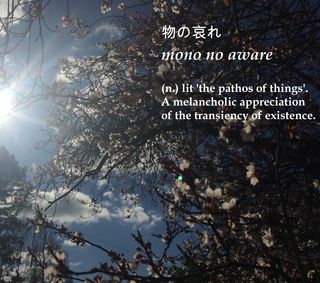Beauty
Seeing Through New Eyes: The Value of 'Untranslatable' Words
Learning to find beauty in the fleeting joys of life
Posted March 7, 2016

Cherry blossoms, and the feeling of sad happiness
At this time of year, I'm always moved by the evanescent beauty of the cherry blossoms that appear near my home. They materialise so suddenly, brightening the world after the gloom of winter, delivering a quickening feeling of joy. Yet, mingled with this happiness is a strange melancholy, borne of the knowledge that just as quickly as they arrived, they will disappear, leaving no more than a precious memory. Just like the passage of youth, their grace is all too fleeting. As I reflect upon this curious feeling - hovering on the borderline of happiness and sadness - it feels like there ought to be a word for it. Indeed, there are many feeling and emotions that I can't quite put into words. And so, being unable to capture these transient states, they tend to subside back into the ceaseless stream of my consciousness, unacknowledged, unarticulated, and unremembered. But then, it occurs, maybe such words do exist, but I just haven't encountered them...
A quest for 'untranslatable words'
Driven by such reflections, I resolved to create a lexicography of ‘untranslatable’ words, taken from across the world’s languages. This was partly motivated by curiosity about other cultures, and about whether they conceptualise wellbeing in different ways. A prominent criticism of positive psychology is that its ideas about wellbeing are rather culturally-specific – reflecting the North American context in which the field emerged – yet these concepts are presented as if universally applicable. However, mindful of these critiques, positive psychology is becoming increasingly appreciative of cultural differences in constructions and experiences of wellbeing. It was my hope that this lexicography would contribute to this burgeoning cross-cultural sensitivity. And, since being published by the Journal of Positive Psychology, it seems to have piqued people's interest.
But the project was also driven by a more personal mission. I wanted to expand my own emotional horizons, and I hoped that these words would enable me to do that. I imagined each of these words as being a key, unlocking new experiences which had previously been closed off to me. And these words were indeed a rich treasure trove, and I have loved dwelling upon them. Perhaps above all, I’m entranced by a series of intriguing Japanese words that really seem to capture the spirit of second wave positive psychology. In their various ways, these words all manage to find some slender, precious beauty in life, even in phenomena that do not initially appear bright and cheery. And, one of these terms does seem to capture the sad happiness evoked by the transiency of those cherry blossoms: mono no aware (物の哀れ).
Mono no aware
The term mono no aware was coined by the eighteenth century literary scholar Motoori Norinaga, by combining aware, which means sensitivity or sadness, and mono, which refers to ‘things.’ Norinaga saw this mood as epitomising a Japanese aesthetic sensibility, characterised by pathos at the fleeting, impermanent nature of life. This is reflecting in the haunting opening lines of The Tale of the Heike, the epic 14th Century Japanese folktale:
The sound of the Gion shōja bells echoes the impermanence of all things…The proud do not endure, they are like a dream on a spring night.
Recognition of the impermanence and transience of life is a central tenet of Buddhism, which has had a pivotal role in shaping the culture of Japan. In Buddhism, life is seen as being marked by three key qualities. The first two are impermanence and insubstantiality, referred to in Japanese as mujō (無常) and muga (無我) respectively. However, unfortunately, we mostly live in hopeful denial of these two aspects of existence, clinging in vain to phenomena that are inherently subject to change. This kind of clinging is then seen as the cause of the third ‘mark’ of existence, namely kǔ (苦), which translates as dissatisfaction or suffering. However, the promise of Buddhism is that liberation can be found through a deep understanding and acceptance of mujō and muga.
This is where the value and beauty of mono no aware makes itself felt. In this mood, impermanence and insubstantiality are not only accepted, deep down; going further, one is able to glimpse a tender appreciation of this ephemerality. This does not mean that impermanence is welcomed or celebrated, of course. Sadness is still inherent in mono no aware, which is imbued with sorrow at this inevitable transiency, at the loss of people and things that are precious to us. However, this melancholy is suffused with a quiet but heartfelt gladness that we had the chance to witness the beauty of life at all, however fleetingly. With mono no aware, we are sighing rather than weeping. This mood was captured with particular genius by the poet Matsuo Bashō (1644-1694), arguably the greatest master of the Haiku. Many of his poems are revered as perfectly articulating mono no aware, perhaps above all this…
Summer grasses – the only remains, of warriors’ dreams.
Moreover, mono no aware recognises that this ephemerality is somehow integral to beauty, that beauty depends on this kind of transiency. In Zen the pre-eminent symbol of mono no aware is the cherry blossom, whose fragile bloom delights us so briefly during the first flush of spring, and which can evoke the strange kind of sad happiness I described above. Crucially, our appreciation of its beauty is heightened by our awareness of its transiency, in a way that would be missing if its delicate blossoms were a permanent feature of our landscape. And as we reflect on this intertwining of beauty and transciency, it may perhaps elevate our appreciation of all that is dear to us. As expressed by Yoshida Kenkō (1283-1350):
If man were never to fade away like the dews of Adashino… how things would lose their power to move us!
And so, as I reflect on mono no aware, it feels that this term does have the potential to expand our emotional horizons. After all, what if we could learn to see all the world through such appreciative eyes?


